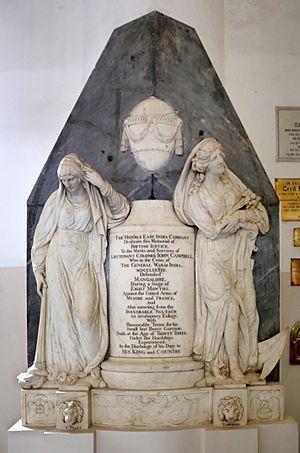John Campbell of Stonefield facts for kids
Quick facts for kids
John Campbell, of Stonefield
|
|
|---|---|
 |
|
| Born | 7 December 1753 |
| Died | 23 March 1784 (aged 30) |
| Occupation | British Army officer |
| Known for | Defence of Mangalore |
John Campbell (born 1753, died 1784) was a brave Scottish soldier. He was a Lieutenant-Colonel in the British Army. He became famous for defending a place called Mangalore in India.
Contents
Growing Up
John Campbell was born in Dumbarton, Scotland, on December 7, 1753. His father, also named John Campbell, was an important judge. His mother, Lady Grace Stuart, was the sister of a powerful nobleman. John went to school at the Royal High School in Edinburgh from 1759 to 1763.
Joining the Army
John Campbell joined the army when he was 17 years old. He became an ensign in the 37th Regiment of Foot in 1771. Later, in 1774, he became a lieutenant in the 7th Fusiliers.
Fighting in America
Campbell served in Quebec, which is now part of Canada. This was during the American Revolutionary War. In 1775, he was captured during the Siege of Fort St. Jean. After he was released, he continued to fight in the war. He became a captain in 1775 and a major in 1777. He was part of the 71st Regiment of Foot (Fraser's Highlanders) and later the 74th Regiment of Foot (Argyleshire Highlanders).
Moving to India
In 1780, Campbell returned to England. He then joined the 100th Regiment of Foot. He quickly moved up the ranks, becoming a major and then a lieutenant-colonel in 1781.
His troops were supposed to go to the Cape (in South Africa). But they were sent to India instead, to help defend it. Campbell arrived in Bombay (now Mumbai) in January 1782. He then joined the 2nd battalion of the Black Watch regiment. He took command of this group during the Second Anglo-Mysore War.
Battles in India
In early 1783, Campbell showed great bravery. He led his troops to victory against Tipu Sultan at a place called Paniana. During this battle, he was seriously wounded. After that, his forces successfully attacked the fort of Anantapur on the Malabar coast.
The Siege of Mangalore
In May 1783, the main commander, General Richard Matthews, was removed from his position. So, John Campbell was given temporary command of the important fort of Mangalore. He had about 1,883 soldiers with him. Soon after, Tipu Sultan's large army surrounded Mangalore, cutting off Campbell and his men.
Holding the Fort
Campbell and his soldiers defended Mangalore against Tipu Sultan's direct attacks. The siege lasted from May 23 to August 2, 1783. During this time, 749 of Campbell's soldiers were killed or wounded. Campbell then agreed to a truce, which meant a temporary stop to the fighting.
The siege then turned into a blockade. This meant Tipu Sultan's army stayed around the fort, stopping supplies from getting in. The blockade continued until January 24, 1784. By then, many of Campbell's soldiers were sick and tired from lack of food and harsh conditions. Only 856 men were still able to fight.
Campbell's defense of Mangalore was very important. It kept almost all of Tipu Sultan's huge army busy for eight months. Tipu Sultan had about 140,000 men and 100 cannons! On January 30, 1784, Campbell and his defenders finally surrendered to Tipu Sultan. They were given excellent terms, meaning they could leave with full military honors. They sailed to Tellicherry.
His Death
Sadly, John Campbell died in Bombay on March 23, 1784. He had a lung illness called consumption, which was made worse by how tired he was from the war. He was buried in St. Thomas Cathedral, Mumbai. A special monument was made for him by a sculptor named Charles Peart.

